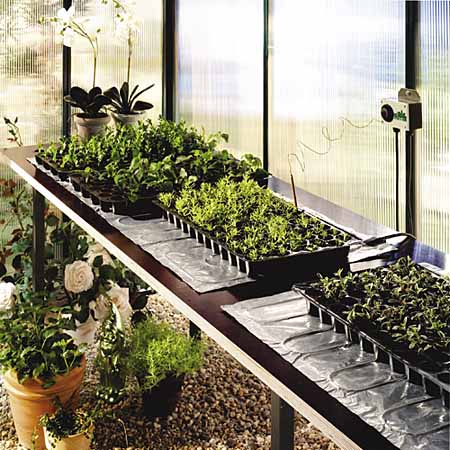
A greenhouse can be a great asset when starting seeds or growing vegetables in your garden. It extends the growing season and can even provide you with fresh vegetables through the winter and early spring. Successful vegetable growing requires the right environment in your greenhouse. Environmental elements to be considered are heat in cold months, cooling in warm months, ventilation & air circulation, shading, humidity, lighting and more.
Starting Seeds
Seed starting for the summer or winter vegetable garden is a very common use for a greenhouse. With a greenhouse, you can get an early start to your garden or even have vegetables year round. Needed seed starting supplies are containers, sterile soil, fertilizer, water, and, especially for northern gardeners, heat and light. A relatively inexpensive way to start seeds is using a propagation mat under seed flats. This provides warmth directly to the soil to help with germination. An alternative to using flats is to plant seeds directly into a soil bench. Warmth can be provided with a heat cable buried about 6 inches in the soil.
Heating
Heat in the greenhouse can be provided with electric, natural gas or LP gas heaters. Electric heaters are flexible, economical, and easy to install with 240-volt heaters generally being more efficient than 120 volt. However, a 120-volt heater is usually adequate for heating a small greenhouse when controlled by a separate heavy-duty, moisture resistant thermostat. Natural gas and LP heaters should be properly vented, both providing fresh air for combustion and exhausting fumes, and equipped with a good thermostat. Other, less common heating methods include in-the-floor radiant heating or an extension of a forced-air home heating system to an attached greenhouse.
Lighting
Once the seeds come up they need light. If the natural light in your greenhouse is low (a common issue in winter), providing supplemental lighting is important to keep plants from getting spindly. A simple fluorescent shop light hung about 4 inches above your plants may be enough. However, many growers prefer to use High Output Fluorescent lamps, High Pressure Sodium, Metal Halide, or LED grow lights. These specialized lights provide strong, full spectrum light and can often cover a larger area than ordinary fluorescent. The high output fluorescent lamps and LED grow lights are energy efficient as well.
Vegetables to Grow in the Winter Greenhouse
Vegetables commonly grown in a winter greenhouse include lettuce, spinach, radishes, tomatoes, peppers, and cucumbers. However, what you are actually able to successfully grow depends on the nighttime temperatures you decide to keep. A cool greenhouse, with nighttime temperatures of 40-45°F, works for lettuce, spinach and radishes. Peppers, tomatoes, and cucumbers need warmer temperatures at night, around 65°F, especially when fruit is growing.
Pollination
Vegetables growing in a greenhouse often need help with pollination. Standard cucumbers will need hand pollination, taking the male blossom and gently rubbing the female blossom center. Tomatoes and peppers are self-pollinating but the blossoms should be gently shaken or vibrated on a regular basis. Circulation fans can help move plants. A preferred alternative is to look in seed catalogs for varieties of seeds that are appropriate for greenhouse production, often due to their method of pollination.
Watering
Water is needed but the amount and frequency varies with temperatures, day length, plant size and your growing medium. It is recommended that the plants be thoroughly soaked at every watering. In January, watering may be needed every 10 to 14 days. As the days get warmer, the frequency should be increased. A flat of seedlings being warmed by a heat mat will also dry out more quickly. When watering, avoid splashing foliage to prevent spreading diseases.
Ventilation
In the winter, it can be difficult to prevent the growth of mold and mildew. Do not over water and help control humidity with proper ventilation and air circulation. For air circulation I recommend an oscillating fan running 24/7 all year long. For ventilation in the warmer months, the gentlest form of ventilation is through natural convection with base wall vents or jalousie (louvered) windows pulling cool air in down low, with roof vents allowing hot air out through the roof.
Cooling
Positive cooling is usually not needed in a greenhouse as long as adequate humidity and shading is provided on hot days. If positive cooling is needed I suggest using evaporative air coolers, which humidify as they cool. Air conditioners are not good for plants since they remove moisture from the air.
Samantha Michaels is an avid gardener and freelance writer.
Related Articles & Free Email Newsletter
Cold Frames Offer an Easy Start to Greenhouse Gardening
Passive Solar Heating for Greenhouse Operations



Comment here